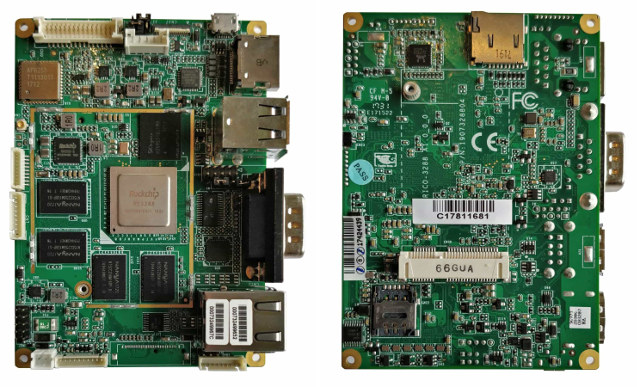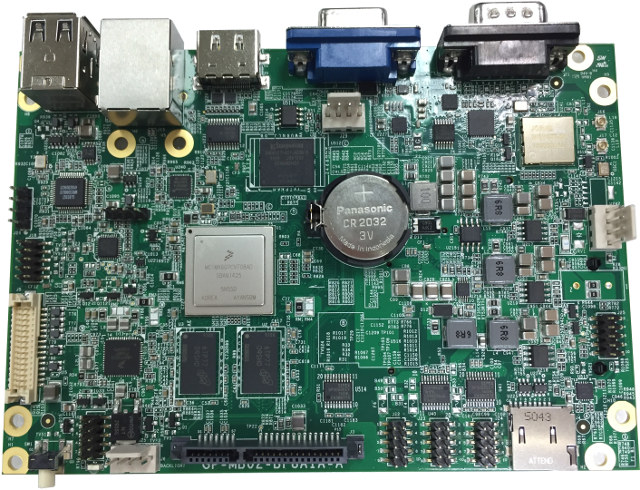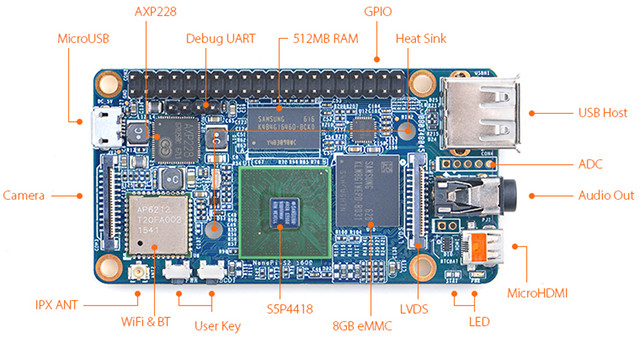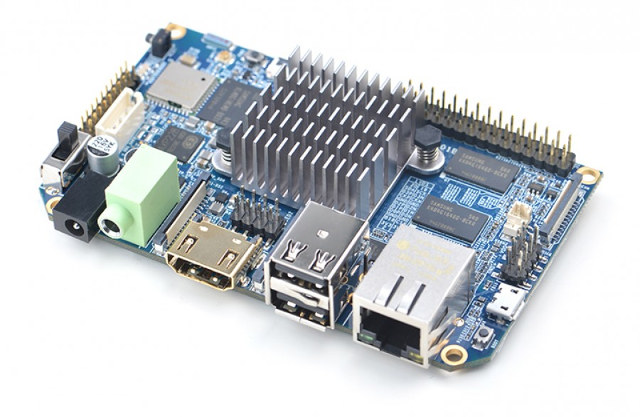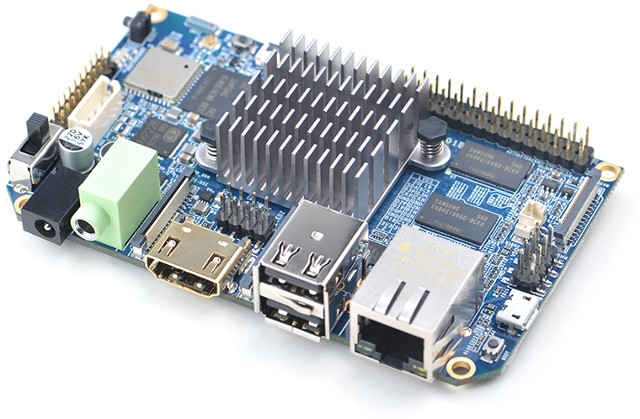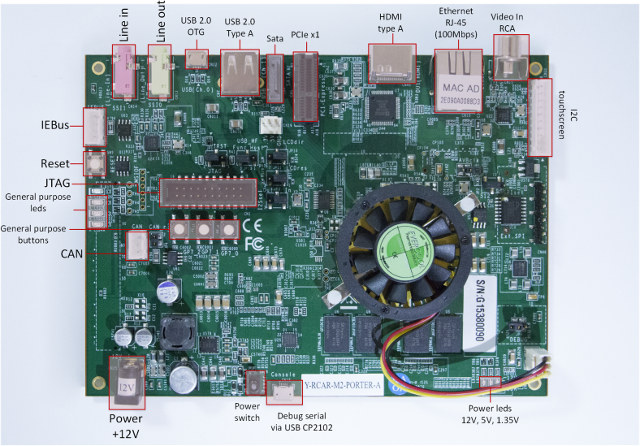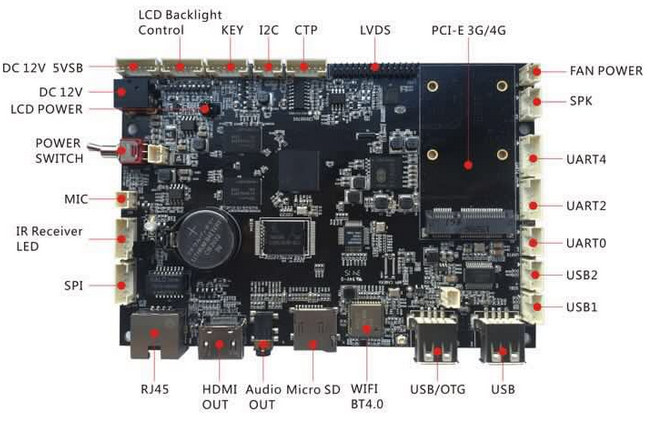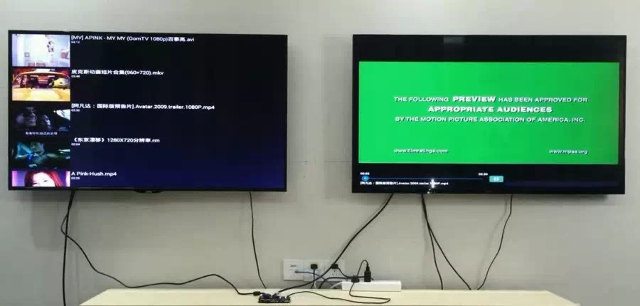Yesterday, as I published Linux 4.15 changelog for Arm and MIPS, I discovered a new Rockchip RK3288 platform described as “Amarula Vyasa single board computer”, so that got me interested. The full name of the company is “Amarula Electronics Limited Sony UK”, which means Vyasa is the name of the board. Amarula Vyasa relies on a 2.5″ Pico-ITX form factor, and is available in either commercial and wide temperature (WiTAS) range. The board is equipped with 2GB RAM, 16GB eMMC flash, exposes ports and connectors such as HDMI 2.0, eDP, and LVDS, and plenty of network connectivity (WiFi, Ethernet, mPCIe modem…) that would make it suitable for a connected digital signage, or other applications requiring a (touchscreen) display and redundant Internet / network connectivity. Amarula Vyasa specifications: SoC – CPU Rockchip RK3288 (ARM CortexTM -A17 Quad-core 1.6GHz) System Memory – 2GB DDR3L SDRAM Storage – 16GB eMMC flash, Micro SD […]
NutsBoard Pistachio 3.5″ Embedded SBC is Powered by NXP i.MX 6Dual/Quad Processor
I don’t write about i.MX6 solutions much anymore, since there are so many options available on the market, but Pistachio SBC has been designed by a company I had never heard of before: NutsBoard, and they’ve released documentation and software publicly, which does not always happen in the industrial/embedded space. Pistachio single board computer specifications: SoC – NXP ARM Cortex-A9 IMX6 Quad/Dual @ 800MHz System Memory – Up to 2GB LPDDR3 Storage – 4GB eMMC flash, 1x SATA interface, 1x micro SD card slot Display I/F / Video Output 2x LVDS (6 or 8 bit) 1x 24-bit VGA output 1x HDMI port up to 1920×1080 (FHD) 1x I2C AR1021 touch controller Audio – SGTL5000 audio codec with class D amplifier; 1x audio header for speaker and microphone Connectivity – Gigabit Ethernet (Qualcomm AR8035), industrial grade wireless module (Jorjin WG7833) with dual band WiFi 802.11 a/b/g/n, Bluetooth 4.2 USB – 4x […]
NanoPi S2 Quad Core ARM Linux Board Comes with WiFi & BT Connectivity, HDMI, LVDS, and LCD Interfaces
FriendlyARM has released a bunch of Allwinner based NanoPi Allwinner boards recently, but they also have some Samsung/Nexcell S5P ARM Cortex A9 boards in their portfolio, and the latest is NanoPi S2 with Samsung S5P4418 quad core processor, three display interfaces, a camera interface, wireless connectivity through WiFi and Bluetooth 4.0, a 40-pin “Raspberry Pi” header, and more. NanoPi S2 specifications: SoC – Samsung/Nexcell S5P4418 quad core Cortex A9 processor @ 400 MHz to 1.4 GHz with Mali-400MP GPU System Memory – 1 GB DDR3 Storage – 8GB eMMC flash + micro SD slot Video Output / Display I/F – micro HDMI port up to 1080p60, 24-pin LCD RGB interface, 24-pin LVDS interface Audio – 3.5mm audio jack, micro HDMI Camera – 24-pin DVP camera interface Connectivity – 802.11 b/g/n WiFi + Bluetooth 4.0 classic & LE (AP6212 module); IPEX/u.FL antenna connector USB – 1x USB 2.0 Host, 1x micro […]
NanoPC-T3 Octa-core Cortex A53 Single Board Computer Sells for $60
FriendlyARM launched NanoPC-T2 single board computer based on Samsung 5P4418 quad core Cortex A9 processor about 3 months ago, and the company has now an update based on Samsung S5P6818 Octa-Core A53 processor with the exact same interfaces and features including Gigabit Ethernet, WiFI, and Bluetooth, HDMI 1.4a, 30-pin expansion headers, etc… NanoPC-T3 specifications: SoC – Samsung S5P6818 octa core Cortex A53 processor @ up to 1.4GHz with Mali-400MP GPU System Memory – 1 or 2GB 32bit DDR3 RAM Storage – 8GB eMMC flash, and 1x SD card slot Connectivity – Gigabit Ethernet (RTL8211E), 802.11 b/g/n WiFi and Bluetooth LE 4.0 (Ampak AP6212) with on-board chip antenna and IPX antenna connector Video Output / Display I/F- 1x HDMI 1.4a, LVDS, MIPI DSI, parallel RGB LCD Audio I/O – HDMI, 3.5mm audio jack, on-board microphone Camera – 1x DVP interface, 1x MIPI CSI interface USB – 2x USB 2.0 type A host […]
FriendlyARM NanoPC-T2 Board Gets More Storage, WiFi & Bluetooth, Stays Cool, and Costs Less
FriendlyARM NanoPC-T1 board powered by Samsung Exynos 4412 processor with 1GB RAM and 4GB eMMC flash was unveiled at the start of 2014 for $69. The company has now announced NanoPC-T2 with Samsung S5P4418 processor with 1GB RAM, and 8GB Flash, as well as WiFi and Bluetooth, as Gigabit Ethernet all of which were missing in the first version. NanoPC-T2 also has a power management chip, and a larger heatsink, meaning that it does not suffer from overheating like NanoPi2 according to FriendlyARM. NanoPC-T2 specifications: SoC – Samsung S5P4418 quad core Cortex A9 processor @ up to 1.4GHz with Mali-400MP GPU System Memory – 1GB 32bit DDR3 RAM Storage – 8GB eMMC flash, and 1x SD card slot (on the bottom of the board) Connectivity – Gigabit Ethernet, 802.11 b/g/n WiFi and Bluetooth LE 4.0 (Ampak AP6212) with on-board chip antenna and 1x IPX antenna connector Video Output / Display […]
Renesas R-Car M2 Porter is a Linux Development Board for Your Car
So far, I always assumed development boards specifically designed for automotive applications would only be available to companies in the car or truck business, but as I wrote about FOSDEM 2016 schedule yesterday, I found out that one of the talk with cover FOSS software stacks that are available for automotive, and usable on hobbyist boards such as Raspberry Pi 2 and Minnowboard Max, but also on Renesas R-Car M2 Porter board specifically designed for automotive infotainment applications. Renesas Port board specifications: SoC – Renesas R-Car M2 dual core ARM Cortex-A15 processor @ 1.5GHz with PowerVR SGX544MP2 GPU, Renesas 2D graphics processor, and Multimedia Engine SH4A @ 780 MHz System Memory – Dual channel 2GB DDR3 Storage – On-board 4 MB SPI, and 64 MB SPI, 1x SATA rev 3.1 connector, 1x SD card slot, and 1x micro SD card slot Video Output / Display I/F – HDMI and LVDS […]
ADBoard 3G/4G Digital Signage Board is Powered by Allwinner A83T Octa-Core Processor
MQMaker officially launched their WiTi router board earlier this week, but the company has also introduced ADBoard, an octa-core board specifically designed for digital signage with a connector for LVDS display including backlight, an RTC with backup battery, and a mini PCIe connector for 3G/4G connectivity combined with a SIM card slot. ADBoard specifications: SoC – Allwinner A83T octa-core ARM Cortex-A7 @ 2.0 GHz with PowerVR SGX544MP GPU @ 700 MHz supporting OpenGL ES 2.0/1.1, OpenCL 1.1, and DX 9.3. System Memory – 1 GB DDR3 Storage – 16 GB eMMC + micro SD slot Display Interfaces / Video Output HDMI up to 1080p60 with HDCP 1.2 and CEC support connector LVDS connector, LCD backlight control header and capacitive touch panel header Audio – HDMI, 3.5mm audio output, speaker connector, microphone connector Connectivity – Gigabit Ethernet, 802.11 b/g/n Wi-Fi and Bluetooth 4.0 USB – 1x USB 2.0 host port, 1x […]
Independent Dual Display Support on Firefly-RK3288 Development Board (Video)
From time to time, I’m being asked which platform can support dual independent displays, and although I noticed Mele A1000 (Allwinner A10) did support dual displays in Linux, I never really investigated how well it handles it, so I normally recommend to have a look at x86 platforms with AMD or Intel processor that specifically claim support for dual independent display. But today, I’ve noticed a developer working for T-Chip posted a nice demo on T-Firefly forums with two displays connected via HDMI and VGA. The demo shows Firefly-RK3288 development board running Android with two displays in three configurations: Display Mirroring – The same content is shown on both display. Especially useful for digital signage application, where one board can drive two displays with the same content Extended Desktop – The user interface is extended on both monitors. It’s like having a single large monitor with a 32:9 aspect ratio […]


